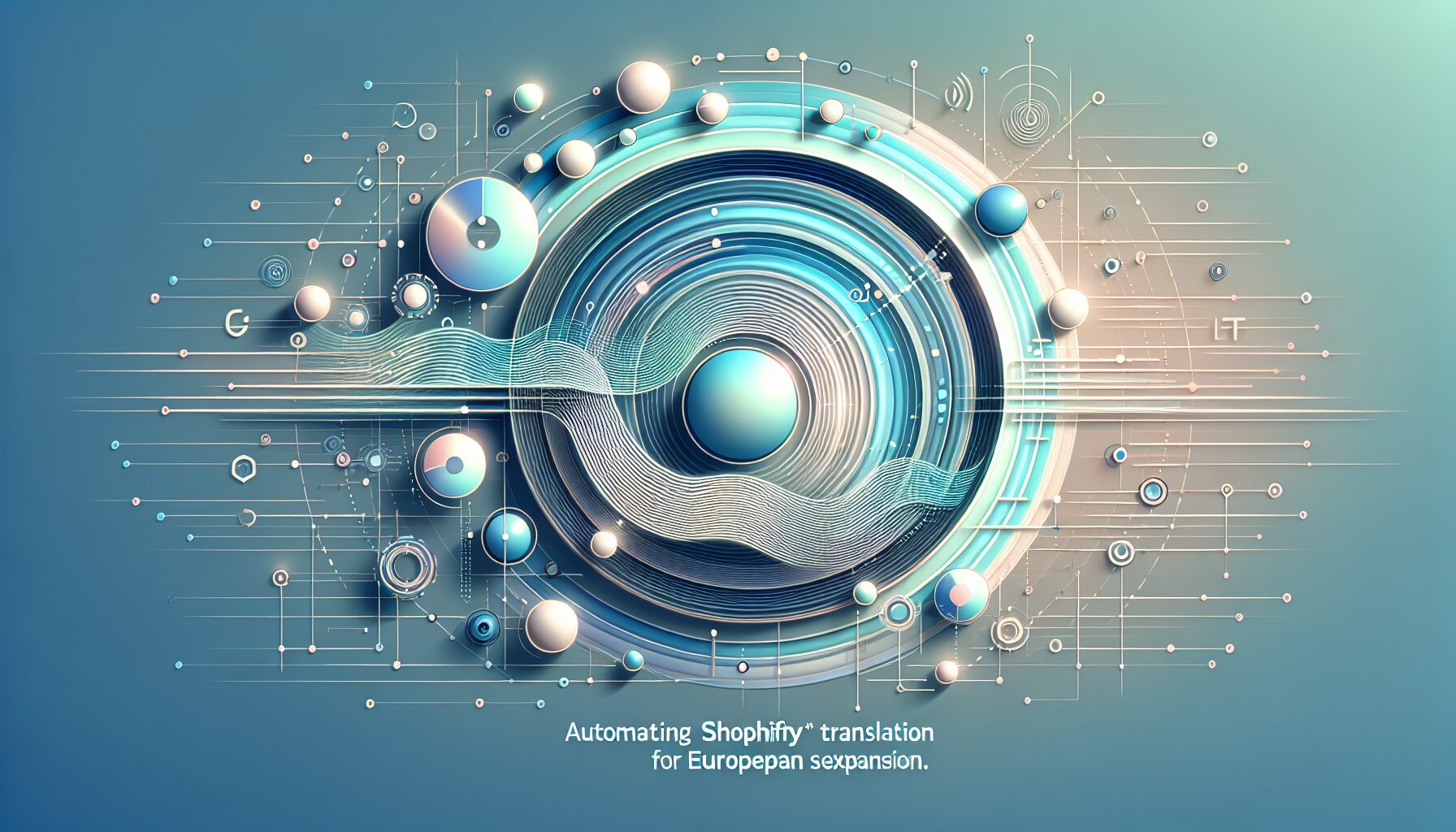About eldris
Clone.Eldris.ai empowers brands to instantly replicate and translate their websites for seamless global expansion. Our automated system delivers SEO-friendly, multilingual clones that launch in days, not months.
In This Article
- Use automated tools to maintain consistency and speed across translations.
- Always pair machine translation with native review for business-critical content.
- Adapt SEO strategy to the nuances of German and French search engines.
- Ensure checkout, legal, and payment flows match local expectations.
- Use multilingual KPIs to optimise translation performance post-deployment.
- Design intuitive language selectors to enhance UX and reduce bounce rates.
Why Automate Shopify Translation for the EU?
Key Benefits of Translation Automation
Online retailers seeking to expand into European markets quickly find themselves facing one common challenge—language. When selling in regions like Germany and France, local language preferences dominate consumer trust and purchasing intent. To automate Shopify translation is not only an efficiency booster; it’s a business necessity.
Manual translation is both time-consuming and prone to inaccuracies, leading to potential brand damage and customer abandonment. On the other hand, automation provides consistency in tone, accelerates time to market, and reduces overhead costs. Automated translation tools allow merchants to maintain massive product catalogues across languages with minimal burnout from staff. Scalability becomes not just achievable, but a competitive differentiator.
When attempting to localise content for German or French consumers, understanding the subtle nuances in grammar, syntax, and tone is essential. Automation platforms not only translate but also incorporate localisation-specific rules—something that manual translations often miss unless done by expensive native experts. Furthermore, automated systems easily integrate with your Shopify backend, removing redundancy and continually syncing new product entries or content changes across languages.

Understanding German and French Market Differences
Market Needs and Language Nuances
Germany and France represent two of the largest ecommerce markets in Europe but differ significantly in consumer behaviour, basket sizes, and linguistic culture. For example, German customers expect detailed product specifications, formal tone, and a logical structure in descriptions. Conversely, French consumers lean towards persuasive language and strong storytelling in product narratives.
These differences greatly affect how translations are perceived. A literal translation across both markets can result in alienating one segment. This is why when you automate Shopify translation, your chosen tool must support cultural localisation—adjusting copy to address country-specific behaviours, not just convert the text linguistically.
Consider also the legal aspects. Germany imposes strict compliance requirements on how terms and conditions, warranty disclaimers, and return policies are presented. Accuracy in translation is therefore not just about user experience—it becomes a matter of legal obligation. Automation platforms can be configured with templates that reflect local standards, saving merchants from costly penalties or site takedowns.
“Translation is more than words; it’s about trust. Automated localisation is how global stores earn regional confidence.”
Shopify Translation Tools to Use
There are several options within the Shopify ecosystem that make it easier to automate Shopify translation. Native options such as Shopify Translate & Adapt offer built-in support for multiple languages and work seamlessly with dynamic UI elements. However, for sellers dealing with large catalogues or more demanding localisation requirements, third-party apps like Langify, Weglot, and T Lab provide deeper customisation and API integrations.
Each tool offers various levels of machine translation quality, post-editing capabilities, and SEO string handling. For example, Weglot uses neural machine translation from providers like DeepL and Google Translate, but also allows human touchpoints via in-dashboard editing or team-based workflow approvals. Langify, on the other hand, supports manual translation uploads in conjunction with automated triggers, giving you layered control over final output.
It’s advisable to prioritise tools that natively support SEO metadata translation, JSON script recognition (for dynamic field translations), and image alt text synchronisation. Additionally, integration with commonly used CMS platforms, review apps or inventory management systems strengthens consistency across the ecommerce stack.
Preparing Legal and Payment Infrastructure
As part of the internationalisation pipeline, adapting your legal framework and payment solutions for Germany and France should go hand in hand as you automate Shopify translation. Legal disclaimers, cookie consent banners, data storage compliance (especially GDPR adherence), and tax regulations must be translated accurately and aligned with regional laws.
Most Shopify stores use plugins or custom blocks to present terms and condition pages, privacy policies, and refund clauses. Ensure all of these formats are multilingual-ready before deploying content changes. Automated tools with custom template mapping make this scalable and legally compliant.
On the payment side, banks and consumers in France and Germany have their own expectations. Germans prefer bank transfers, PayPal, and Klarna. French buyers lean towards Carte Bancaire, Paylib, and Apple Pay. Payment gateways must be connected to translated checkout experiences reflecting local security and cultural flow. Missteps here will result in cart abandonment and reputation loss.
Optimising for SEO in Multilingual Shopify Stores
The SEO advantage of a multilingual Shopify store is often underleveraged. When you automate Shopify translation, it’s crucial to extend automation to metadata—page titles, meta descriptions, canonical tags, and URL structures must all reflect the target language and local search intent.
Search engines in Germany and France differ in ranking logic due to localisation. For example, Google.fr prioritises different keyword variations than Google.de, even for similar products. Language-specific keyword research must accompany translation. Tools like Ahrefs, SEMrush, or Google Keyword Planner help uncover French and German semantic variants.
Use hreflang tags properly, especially across country-language subdirectories or domains. Shopify handles some of this automatically, but advanced users may choose custom logic to optimise multilingual crawlability. Including translated alt text for images and localised structured data (schema markup) further boosts visibility.
Lastly, encourage backlinks from local domains (.de or .fr extensions) to your translated pages. This not only improves local authority but signals strong regional relevance to search engines. Don’t forget to implement regionally appropriate trust badges or third-party certification logos that reassure users.
How to Handle Product Descriptions Consistently
Maintaining consistency across translated product descriptions is challenging without the right approach. To effectively automate Shopify translation, start with well-structured master content. Automations rely on data structure to interpret meaning, so investing in rich, clear English source content is foundational.
Use Shopify’s product metafields to store multiple language variants in parallel, enabling full control over custom fields. Translation tools should be configured to detect and update these metafields on action triggers, such as new product uploads or inventory re-marketing campaigns.
For added efficiency, implement translation memory features via your chosen platform. This helps the tool remember previously translated content and apply consistent phrasing across collections. It reduces workload and ensures brand tone is maintained across similar product lines or revisions.
Human oversight is advised post-automation. Implement a review stage where native speakers confirm intent, especially for high-traffic or high-ticket items. Pair this with AI-powered linguistic QA (quality assurance) logs that highlight anomalies.
Scaling Translation Across Collections
As product ranges expand, keeping translations aligned becomes increasingly complex. With the robust capabilities available to automate Shopify translation, you can scale seamlessly across dozens—or hundreds—of collections using batch processing.
Identify the product templates and attributes shared across multiple SKUs. Once segmentation is in place, you can apply template-driven translation logic to save time. Translation engines like DeepL or Microsoft Azure Translation integrate into Shopify apps and allow bulk feeds via CSV or API.
If your store updates frequently, apply triggers for real-time translation transformation. For example, publish events can fire off content syncs to German and French versions almost instantly. Add moderation steps or translation flags for sensitive content or where nuances are more critical than speed.
Scalability becomes particularly important when running seasonal or time-bound promotions. Automating the translation of promotional banners ensures simultaneous launches across markets, maximising campaign impact.
Storefront Language Selection UX Design
User experience (UX) plays a pivotal role in multilingual ecommerce. An effective language selector must be intuitive, fast, and visible—never buried within the footer or dependent solely on browser detection. When you automate Shopify translation, it is vital that users can access translated content via a frictionless visual cue, such as a country flag dropdown in your header.
Avoid automatic redirection based on geolocation unless explicitly confirmed by the user. This can lead to poor experiences, especially with VPN usage or accidental misclassification. Instead, combine IP detection with user selection memory—cookies storing preferences across sessions.
Ensure your UX design includes translated navigation menus, cart and checkout pages, breadcrumbs, and help desk content. The goal is full immersion, not partial translation. Incomplete localisation looks unprofessional and erodes trust.
Accessibility should also factor in. Ensure screen readers and keyboard navigation function properly across all language variants. This enhances not only user satisfaction but compliance with European accessibility laws.
Measuring Success Post-Launch
To validate the ROI of efforts to automate Shopify translation, track key performance indicators (KPIs) across your multilingual storefront. Conversion rate differences between English, German, and French variants will provide immediate insight into localisation effectiveness.
Engage analytics tools to monitor bounce rates, time on page, and source traffic channel per language. Use Shopify’s integrated analytics or plug in tools like GA4, Matomo, or Hotjar with multilingual segmentation support.
Also monitor cart abandonment by market. This often reflects unmet trust signals or localisation gaps. Feedback loops via customer surveys or embedded review platforms (e.g., Trustpilot, Feefo) can yield qualitative feedback on linguistic or experiential shortcomings.
Your support inbox is also telling—track if queries reflect confusion with translated instructions or unclear policies. Constant iteration based on live data lets your translation automation grow smarter, faster, and ultimately more profitable.
Common Pitfalls and How to Avoid Them
Over-relying on automation without human evaluation is a top mistake. While tools to automate Shopify translation are powerful, unchecked translations can lead to grammatical errors, cultural blunders, or legal issues.
Another pitfall is mismanaging multiple currencies and payment flows alongside language changes. Don’t assume language preference equals regional residency. Always show pricing adapted to currency and address format standards.
Avoid using images with embedded text unless you can dynamically translate them. Switch to editable overlays or translatable design elements. Likewise, don’t overlook translated emails—these complete the user journey and must mirror the shop’s frontend.
Finally, neglecting SEO and server-side rendering limits reach. Ensure your sitemap includes all translated URLs, and conduct regular crawl audits per market variant.
Final Thoughts: Localise to Globalise
[CONCLUSION_CONTENT]
Great guide on automate-shopify-translation-germany-france – Community Feedback
How can I automate Shopify translation for Germany and France?
Use automated translation solutions integrated with Shopify to localise your store for German and French markets, ensuring accurate, SEO-optimised content and a seamless customer experience across languages.
What are the essential steps to launch my Shopify store in Germany?
Prepare your translated content, configure local payment and legal settings, automate language selection, and comply with German e-commerce requirements for a smooth launch.
Why is localisation important in France for e-commerce growth?
French consumers value localised experiences, including correct language, currencies, and legal regulations. Localisation increases trust, conversions, and market competitiveness.










